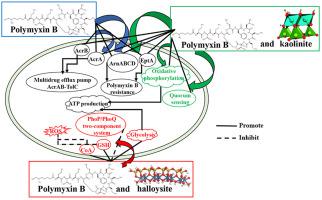Chemosphere ( IF 8.8 ) Pub Date : 2020-11-24 , DOI: 10.1016/j.chemosphere.2020.129095 Juan Liu , Pingxiao Wu , Fang Wang , Wenchao Niu , Zubair Ahmed , Meiqing Chen , Guining Lu , Zhi Dang

|
The reuse of polymyxin B (PMB) has attracted extensive attention. Although the resistance mechanism to PMB is clear, there are few reports on the regulation mechanisms and effects of clay minerals on bacteria induced by PMB. The focus of this study is to investigate the multidrug resistance, cell morphology and physiological modification of Escherichia coli (E. coli) exposed to PMB in the presence and absence of clay minerals. To be specific, E. coli was cultured serially for 15 days in the increasing concentration of PMB, with or without halloysite or kaolinite. The potential influence mechanisms of halloysite and kaolinite on E. coli was analyzed by proteomics, antibiotic resistance testing, confocal laser scanning microscopy, scanning electron microscopy and Fourier transform infrared. The results showed that kaolinite could obviously promote the growth of bacteria. Moreover, compared with halloysite, kaolinite could stimulate the overexpression of PMB resistance-related proteins ArnA, ArnB and EptA in E. coli exposed to PMB, and promote the synthesis of peptidoglycan and activate glycolysis pathway to produce energy. In contrast, halloysite was able to regulate the production of low molecular weight thiols by E. coli to prevent bacteria from producing excessive reactive oxygen species, activate the oxidative phosphorylation pathway to supply energy for bacterial life activities, and reduce multidrug resistance of E. coli in a variety of ways. These findings are essential for exploring the impacts of clay minerals on the emergence and spread of multi-drug resistant strains in the environment.
中文翻译:

多粘菌素B胁迫下黏土矿物对大肠杆菌的差异调节及其潜在机理:埃洛石与高岭石的比较
多粘菌素B(PMB)的再利用引起了广泛的关注。尽管对PMB的抗药性机制很明确,但是关于粘土矿物质对PMB诱导的细菌的调控机制和作用的报道很少。这项研究的重点是研究在存在和不存在粘土矿物的情况下,暴露于PMB的大肠杆菌(E. coli)的多药耐药性,细胞形态和生理修饰。具体而言,大肠杆菌中连续培养15天在PMB,浓度的增大具有或不具有多水高岭土或高岭石。埃洛石和高岭石对大肠杆菌的潜在影响机制通过蛋白质组学,抗生素抗性测试,共聚焦激光扫描显微镜,扫描电子显微镜和傅里叶变换红外光谱进行了分析。结果表明,高岭土可以明显促进细菌的生长。此外,与埃洛石相比,高岭石可刺激暴露于PMB的大肠杆菌中PMB耐药相关蛋白ArnA,ArnB和EptA的过表达,并促进肽聚糖的合成并激活糖酵解途径产生能量。相反,埃洛石能够调节大肠杆菌产生的低分子量硫醇。为了防止细菌产生过量的活性氧,激活氧化磷酸化途径,为细菌的生命活动提供能量,并以多种方式降低大肠杆菌的多药耐药性。这些发现对于探索粘土矿物对环境中多药耐药菌株的出现和传播的影响至关重要。



























 京公网安备 11010802027423号
京公网安备 11010802027423号